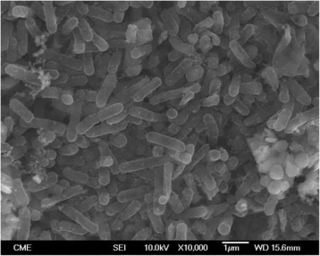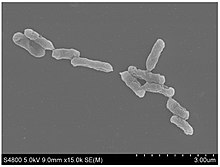Bioleaching is the extraction or liberation of metals from their ores through the use of living organisms. Bioleaching is one of several applications within biohydrometallurgy and several methods are used to treat ores or concentrates containing copper, zinc, lead, arsenic, antimony, nickel, molybdenum, gold, silver, and cobalt.
Bacteria biooxidation is an oxidation process caused by microbes where the valuable metal remains in the solid phase. In this process, the metal remains in the solid phase and the liquid can be discarded. Bacterial oxidation is a biohydrometallurgical process developed for pre-cyanidation treatment of refractory gold ores or concentrates. The bacterial culture is a mixed culture of Acidithiobacillus ferrooxidans, Acidithiobacillus thiooxidans and Leptospirillum ferrooxidans. The bacterial oxidation process comprises contacting refractory sulfide ROM ore or concentrate with a strain of the bacterial culture for a suitable treatment period under an optimum operating environment. The bacteria oxidise the sulfide minerals, thus liberating the occluded gold for subsequent recovery via cyanidation.
Thiobacillus is a genus of Gram-negative Betaproteobacteria. Thiobacillus thioparus is the type species of the genus, and the type strain thereof is the StarkeyT strain, isolated by Robert Starkey in the 1930s from a field at Rutgers University in the United States of America. While over 30 "species" have been named in this genus since it was defined by Martinus Beijerinck in 1904,, most names were never validly or effectively published. The remainder were either reclassified into Paracoccus, Starkeya ; Sulfuriferula, Annwoodia, Thiomonas ; Halothiobacillus, Guyparkeria, or Thermithiobacillus or Acidithiobacillus. The very loosely defined "species" Thiobacillus trautweinii was where sulfur oxidising heterotrophs and chemolithoheterotrophs were assigned in the 1910-1960s era, most of which were probably Pseudomonas species. Many species named in this genus were never deposited in service collections and have been lost.

The Acidithiobacillales are an order of bacteria within the class Acidithiobacillia and comprises the genera Acidithiobacillus and Thermithiobacillus. Originally, both were included in the genus Thiobacillus, but they are not related to the type species, which belongs to the Betaproteobacteria.
Thermithiobacillus is a genus of nonsporeforming, rod-shaped, Gram-negative bacteria. The name derives from the Latin thermae, for warm baths, and the Classical Greek θείος, theios for sulfur. The type species of this genus was previously assigned to the genus Thiobacillus, but it was reclassified on the basis of 16S rRNA analysis in 2000, creating this genus.

Sulfur-reducing bacteria are microorganisms able to reduce elemental sulfur (S0) to hydrogen sulfide (H2S). These microbes use inorganic sulfur compounds as electron acceptors to sustain several activities such as respiration, conserving energy and growth, in absence of oxygen. The final product of these processes, sulfide, has a considerable influence on the chemistry of the environment and, in addition, is used as electron donor for a large variety of microbial metabolisms. Several types of bacteria and many non-methanogenic archaea can reduce sulfur. Microbial sulfur reduction was already shown in early studies, which highlighted the first proof of S0 reduction in a vibrioid bacterium from mud, with sulfur as electron acceptor and H
2 as electron donor. The first pure cultured species of sulfur-reducing bacteria, Desulfuromonas acetoxidans, was discovered in 1976 and described by Pfennig Norbert and Biebel Hanno as an anaerobic sulfur-reducing and acetate-oxidizing bacterium, not able to reduce sulfate. Only few taxa are true sulfur-reducing bacteria, using sulfur reduction as the only or main catabolic reaction. Normally, they couple this reaction with the oxidation of acetate, succinate or other organic compounds. In general, sulfate-reducing bacteria are able to use both sulfate and elemental sulfur as electron acceptors. Thanks to its abundancy and thermodynamic stability, sulfate is the most studied electron acceptor for anaerobic respiration that involves sulfur compounds. Elemental sulfur, however, is very abundant and important, especially in deep-sea hydrothermal vents, hot springs and other extreme environments, making its isolation more difficult. Some bacteria – such as Proteus, Campylobacter, Pseudomonas and Salmonella – have the ability to reduce sulfur, but can also use oxygen and other terminal electron acceptors.

Ferroplasma is a genus of Archaea that belong to the family Ferroplasmaceae. Members of the Ferroplasma are typically acidophillic, pleomorphic, irregularly shaped cocci.
Acidophiles or acidophilic organisms are those that thrive under highly acidic conditions. These organisms can be found in different branches of the tree of life, including Archaea, Bacteria, and Eukarya.
Biomining is the technique of extracting metals from ores and other solid materials typically using prokaryotes, fungi or plants. These organisms secrete different organic compounds that chelate metals from the environment and bring it back to the cell where they are typically used to coordinate electrons. It was discovered in the mid 1900s that microorganisms use metals in the cell. Some microbes can use stable metals such as iron, copper, zinc, and gold as well as unstable atoms such as uranium and thorium. Large chemostats of microbes can be grown to leach metals from their media. These vats of culture can then be transformed into many marketable metal compounds. Biomining is an environmentally friendly technique relative to traditional mining. Mining releases many pollutants while the only chemicals released from biomining is any metabolites or gasses that the bacteria secrete. The same concept can be used for bioremediation models. Bacteria can be inoculated into environments contaminated with metals, oils, or other toxic compounds. The bacteria can clean the environment by absorbing these toxic compounds to create energy in the cell. Bacteria can mine for metals, clean oil spills, purify gold, and use radioactive elements for energy.
Thermithiobacillus tepidarius is a member of the Acidithiobacillia isolated from the thermal groundwaters of the Roman Baths at Bath, Somerset, United Kingdom. It was previously placed in the genus Thiobacillus. The organism is a moderate thermophile, 43–45 °C (109–113 °F), and an obligate aerobic chemolithotrophic autotroph. Despite having an optimum pH of 6.0–7.5, growth can continue to an acid medium of pH 4.8. Growth can only occur on reduced inorganic sulfur compounds and elementary sulfur, but unlike some species in other genus of the same family, Acidithiobacillus, Thermithiobacillus spp. are unable to oxidise ferrous iron or iron-containing minerals.

The outflow of acidic liquids and other pollutants from mines is often catalysed by acid-loving microorganisms; these are the acidophiles in acid mine drainage.

Acidithiobacillus ferrooxidans is a bacterium that sustains its life cycle at extremely low pH values, and it is one of the very few organisms that gain energy from oxidating ferrous iron. It can make copper from ores water-soluble, and it can sequester both carbon and nitrogen from the atmosphere.
Iron:rusticyanin reductase is an enzyme with systematic name Fe(II):rusticyanin oxidoreductase. This enzyme catalyses the following chemical reaction
Leptospirillum ferriphilum is an iron-oxidising bacterium able to exist in environments of high acidity, high iron concentrations, and moderate to moderately high temperatures. It is one of the species responsible for the generation of acid mine drainage and the principal microbe used in industrial biohydrometallurgy processes to extract metals.
Acidithiobacillus caldus formerly belonged to the genus Thiobacillus prior to 2000, when it was reclassified along with a number of other bacterial species into one of three new genera that better categorize sulfur-oxidizing acidophiles. As a member of the Gammaproteobacteria class of Pseudomonadota, A. caldus may be identified as a Gram-negative bacterium that is frequently found in pairs. Considered to be one of the most common microbes involved in biomining, it is capable of oxidizing reduced inorganic sulfur compounds (RISCs) that form during the breakdown of sulfide minerals. The meaning of the prefix acidi- in the name Acidithiobacillus comes from the Latin word acidus, signifying that members of this genus love a sour, acidic environment. Thio is derived from the Greek word thios and describes the use of sulfur as an energy source, and bacillus describes the shape of these microorganisms, which are small rods. The species name, caldus, is derived from the Latin word for warm or hot, denoting this species' love of a warm environment.

Acidithiobacillus thiooxidans, formerly known as Thiobacillus thiooxidans until its reclassification into the newly designated genus Acidithiobacillus of the Acidithiobacillia subclass of Pseudomonadota, is a Gram-negative, rod-shaped bacterium that uses sulfur as its primary energy source. It is mesophilic, with a temperature optimum of 28 °C. This bacterium is commonly found in soil, sewer pipes, and cave biofilms called snottites. A. thiooxidans is used in the mining technique known as bioleaching, where metals are extracted from their ores through the action of microbes.
Acidithrix ferrooxidans is a heterotrophic, acidophilic and Gram-positive bacterium from the genus Acidithrix. The type strain of this species, A. ferrooxidans Py-F3, was isolated from an acidic stream draining from a copper mine in Wales. This species grows in a variety of acidic environments such as streams, mines or geothermal sites. Mine lakes with a redoxcline support growth with ferrous iron as the electron donor. "A. ferrooxidans" grows rapidly in macroscopic streamer, producing greater cell densities than other streamer-forming microbes. Use in a bioreactors to remediate mine waste has been proposed due to cell densities and rapid oxidation of ferrous iron oxidation in acidic mine drainage. Exopolysaccharide production during metal substrate metabolism, such as iron oxidation helps to prevent cell encrustation by minerals.

Microbial oxidation of sulfur is the oxidation of sulfur by microorganisms to build their structural components. The oxidation of inorganic compounds is the strategy primarily used by chemolithotrophic microorganisms to obtain energy to survive, grow and reproduce. Some inorganic forms of reduced sulfur, mainly sulfide (H2S/HS−) and elemental sulfur (S0), can be oxidized by chemolithotrophic sulfur-oxidizing prokaryotes, usually coupled to the reduction of oxygen (O2) or nitrate (NO3−). Anaerobic sulfur oxidizers include photolithoautotrophs that obtain their energy from sunlight, hydrogen from sulfide, and carbon from carbon dioxide (CO2).
Sulfobacillus thermosulfidooxidans is a species of bacteria of the genus Sulfobacillus. It is an acidophilic, mixotrophic, moderately thermophilic, Gram-positive, sporulating facultative anaerobe. As its name suggests, it is capable of oxidizing sulfur.

Sulfobacillus is a genus of bacteria containing six named species. Members of the genus are Gram-positive, acidophilic, spore-forming bacteria that are moderately thermophilic or thermotolerant. All species are facultative anaerobes capable of oxidizing sulfur-containing compounds; they differ in optimal growth temperature and metabolic capacity, particularly in their ability to grow on various organic carbon compounds.







